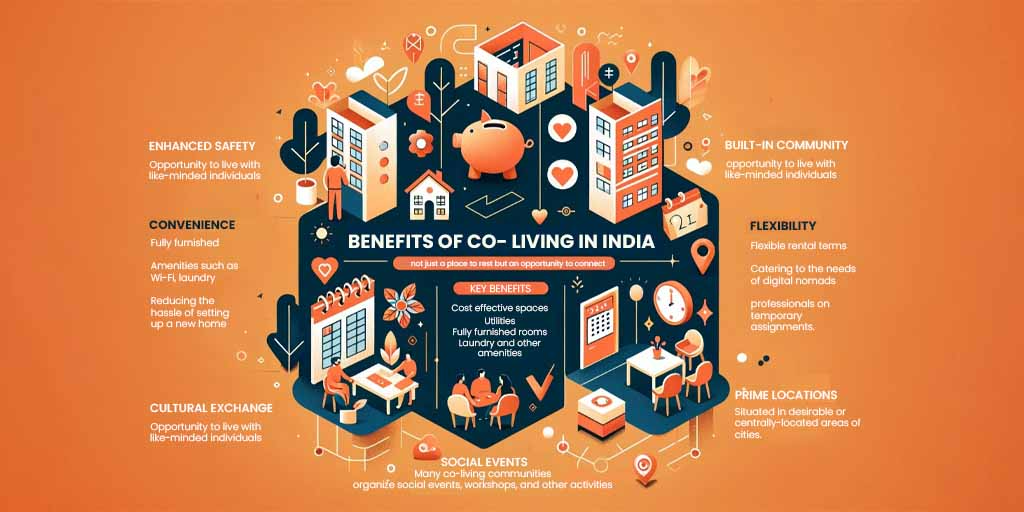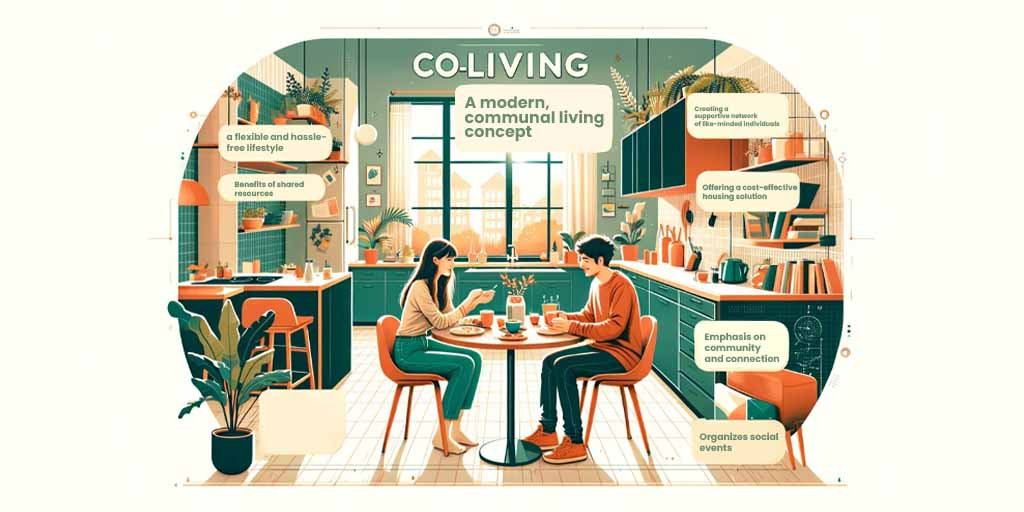Imagine stepping into a world where your living space extends beyond the confines of your room, offering not just a place to rest but an opportunity to connect, collaborate, and grow. Welcome to co-living in India, a revolutionary concept that’s transforming the way we think about community and space.
Here, amidst the diversity and vibrancy of India’s cultural landscape, co-living spaces are not just accommodations but incubators of creativity, friendship, and innovation. Dive into this emerging trend and discover how you can be part of a living experience that’s about more than just sharing a roof, but about creating memories and bonds that last a lifetime. Are you ready to redefine your living standards and embrace the future of urban living?
What is Co-living?
The meaning of co-living extends far beyond the simple sharing of residential spaces. It represents a modern, communal living concept where individuals, often strangers from diverse backgrounds, come together to share common living areas while maintaining private bedrooms.
The essence of co-living lies in its emphasis on community and connection, making it a sought-after living arrangement for many, especially millennials and digital nomads. At its core, the meaning of co-living is about creating a supportive network of like-minded individuals who value collaboration over competition, and who seek to blend their daily lives with the convenience of communal amenities and the opportunity for personal development and social interaction.
This innovative living concept has gained traction globally, including in bustling urban centers where housing affordability and loneliness present significant challenges. Co-living addresses these issues by offering a cost-effective housing solution that also combats the isolation many feel in large cities.
Residents of co-living spaces enjoy the benefits of shared resources such as kitchens, lounges, and workspaces, which not only reduce living costs but also foster a sense of belonging and community. Moreover, co-living spaces often organize social events and professional workshops, further enriching the living experience of their inhabitants.
The meaning of co-living also encompasses a flexible and hassle-free lifestyle. Unlike traditional leases, co-living agreements typically offer more flexible terms, making it an ideal choice for those who value freedom and mobility. Additionally, co-living spaces are often equipped with modern amenities and designed with a focus on sustainability, reflecting the values and priorities of their residents.
History of Co-living
The modern concept of co-living in India, as it is known today, began to emerge around the early 2010s. This period marked the start of a more organized and formal approach to co-living, different from traditional shared housing or hostels. The rise of co-living spaces during this time was driven by urbanization, the growth of the startup culture, and the increasing number of young professionals and students moving to cities in search of opportunities.
While communal living has a long history in India, the specific trend of co-living with a focus on providing flexible, community-oriented living arrangements for millennials and young professionals started gaining significant traction in the early part of the decade.
Benefits of Co-living

- Cost Efficiency: Co-living spaces often come with lower rental costs compared to traditional apartments, as expenses for utilities, furniture, and other amenities are shared among residents.
- Built-in Community: Residents have the opportunity to live with like-minded individuals, fostering a sense of belonging and easing the feelings of loneliness that can come with moving to a new city.
- Flexibility: Many co-living arrangements offer short-term leases or flexible rental terms, catering to the needs of digital nomads, students, and professionals on temporary assignments.
- Convenience: Co-living spaces are typically fully furnished and include amenities such as Wi-Fi, laundry, and sometimes even meals, reducing the hassle of setting up a new home.
- Networking Opportunities: Living in a community of diverse professionals provides ample networking opportunities, potentially leading to collaborations and career advancements.
- Enhanced Safety: Co-living spaces often feature security measures like surveillance cameras and controlled access, providing a safer environment for residents.
- Reduced Household Chores: Shared responsibilities for cleaning and maintenance mean individuals spend less time on household chores, freeing up time for personal and professional pursuits.
- Cultural Exchange: For international residents, co-living offers a unique opportunity to immerse themselves in local cultures and practices, enhancing their living experience abroad.
- Sustainability: By sharing resources and living spaces, co-living can be a more sustainable housing option, reducing individual carbon footprints.
- Access to Prime Locations: Co-living spaces are often situated in desirable or centrally-located areas of cities, where traditional rental costs might be prohibitively expensive for individuals.
- Social Events and Workshops: Many co-living communities organize social events, workshops, and other activities that contribute to personal growth and community engagement.
Challenges of co-living Spaces

- Cultural Adaptation: Adapting to a shared living environment can be challenging for individuals used to more private or traditional family-oriented living arrangements, especially in a culturally diverse country like India.
- Privacy Concerns: The communal nature of co-living spaces might lead to a perceived lack of privacy for some residents, as living areas and amenities are shared.
- Conflict Resolution: With individuals from various backgrounds living together, conflicts may arise due to differences in lifestyle, habits, or expectations, necessitating effective conflict resolution mechanisms.
- Quality and Maintenance Standards: Ensuring consistent quality and maintenance of shared spaces and amenities can be challenging, affecting the overall living experience.
- Regulatory Hurdles: The co-living sector in India may face regulatory challenges, including zoning laws and licensing, which can hinder the establishment and expansion of co-living spaces.
- Market Saturation: In urban centers, the increasing number of co-living spaces can lead to market saturation, making it difficult for operators to maintain occupancy rates and profitability.
- Security Concerns: Ensuring the safety and security of residents is paramount, and any lapses can seriously impact the reputation and desirability of a co-living space.
- Scalability Issues: Expanding co-living operations to different cities or regions can be challenging due to varying local demands, cultural differences, and operational logistics.
- Affordability: While co-living is often marketed as a cost-effective option, the pricing in some premium or high-demand locations may still be out of reach for the target demographic of young professionals and students.
- Standardization: The lack of standardization across different co-living spaces in terms of facilities, services, and management practices can lead to inconsistent experiences for residents.
- Adaptability to Local Needs: Tailoring co-living spaces to meet the specific needs and preferences of local populations in different parts of India requires a deep understanding of regional cultures and lifestyles.
FAQs
What is the concept of co-living?
Co-living refers to a modern form of communal living where individuals share living spaces, amenities, and often engage in social activities together, fostering community and shared experiences.
Is co-living legal in India?
Yes, co-living is legal in India and has become increasingly popular, especially among young professionals and students in urban areas.
What is the difference between co-living and room-mates?
Co-living involves shared communal spaces and often includes services and amenities, while having roommates typically means sharing a rental property without additional communal facilities or services.
What is the difference between PG and Co-living?
PG (Paying Guest) accommodations are typically basic lodging options with meals provided, often within a family’s home, focusing on affordability. Co-living, however, offers a more community-oriented living experience, with shared common spaces, amenities, and events, aimed at fostering social connections among residents. Co-living spaces are usually more modern and may include additional services like cleaning and maintenance.

Sridhar Reddy, the innovative entrepreneur behind Serenity Hostels, is a visionary figure redefining hostel culture in Bangalore. As the founder and director of Serenity Hostels, Reddy has not only emphasized the importance of rooms but has also focused on creating a nurturing environment that serves as a second home for students. His sharpness and forward-thinking approach have been pivotal in positioning Serenity Hostels as the premier choice for student accommodation in the city. Reddy’s journey into the world of student hostels began with a clear mission: to transform the traditional hostel experience into something far more enriching and supportive for students away from home.


